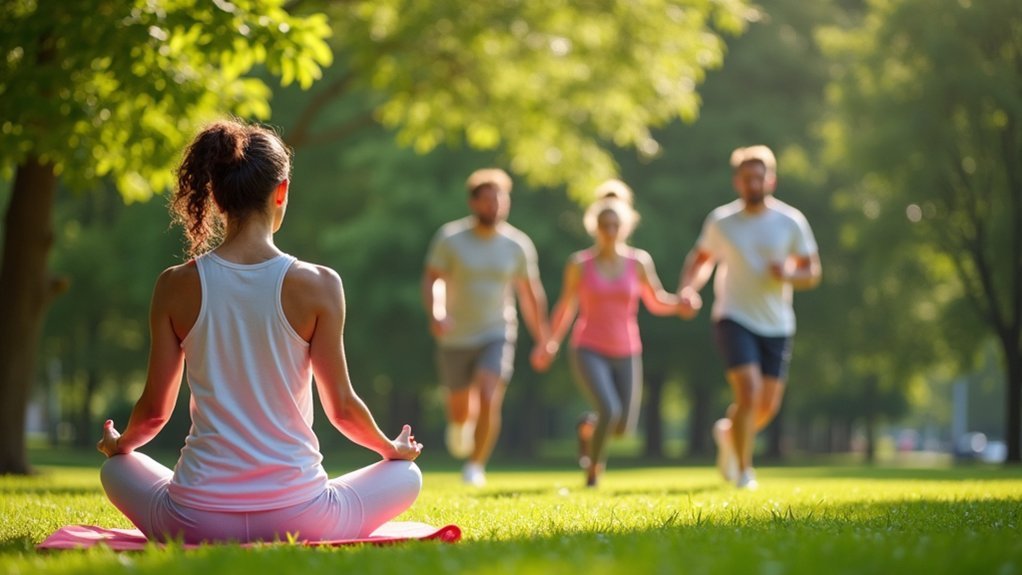Rebounding on a mini-trampoline offers exceptional benefits for lung oxygen flow. You’ll boost respiratory efficiency with gentle bouncing, health-bounce techniques, and interval rebounding that alternates intensity. Try strength-based rebounding with resistance bands or rhythmic rebounding that coordinates breathing with movement. Deep breathing patterns during rebounds enhance cellular oxygenation, while low-impact recovery sessions sustain improvements. These seven approaches transform your respiratory health without harsh impact on joints—discover how each technique uniquely maximizes your oxygen potential.
Gentle Rebounding for Beginners: Controlled Bouncing Techniques

While many exercise routines focus on high-intensity movements, gentle rebounding offers an accessible yet powerful way to enhance your lung function. This controlled bouncing on a mini trampoline improves circulation and oxygen flow throughout your body while strengthening respiratory muscles.
Start with just 5-10 minutes per session as you familiarize yourself with the movement. Maintain proper posture with your chest open and shoulders relaxed to maximize oxygen intake during each bounce. This position activates your diaphragm effectively, supporting better breathing patterns.
Begin your rebounding journey with short sessions. Keep your chest open and shoulders relaxed to optimize breathing and effectively engage your diaphragm.
As you practice consistently, you’ll notice improvements in your lung capacity. The rhythmic bouncing also stimulates your lymphatic system, helping eliminate toxins that can affect lung function.
This low-impact exercise is particularly beneficial if you’re looking to improve respiratory health without straining your joints.
Health-Bounce Rebounding: Increasing Oxygen Circulation
Health-bounce rebounding takes your lung health to the next level by considerably enhancing oxygen circulation throughout your entire body. This low-impact exercise stimulates lymphatic flow while engaging multiple muscle groups, improving respiratory function and oxygen exchange efficiency.
Just 10-15 minutes of regular rebounding can considerably boost your lung capacity and oxygen uptake. The rhythmic bouncing creates a beneficial gravitational effect that enhances lung expansion and oxygen absorption.
| Rebounding Benefit | Impact on Respiratory Health |
|---|---|
| Lymphatic Flow | Enhanced body detoxification |
| Gravitational Effect | Improved lung expansion |
| Cardiovascular Engagement | Increased oxygen circulation |
| Multiple Muscle Use | Better overall oxygen uptake |
| Rhythmic Movement | Reduced shortness of breath |
You’ll notice improved endurance and easier daily activities as your oxygen flow increases with consistent practice.
Interval Rebounding: Alternating Intensity for Lung Capacity

Interval rebounding takes the oxygen-boosting benefits of standard rebounding to a higher level by incorporating strategic intensity changes. This approach alternates between high-intensity bouncing and recovery periods, greatly enhancing your lung capacity while remaining gentle on your joints.
A quick 15-20 minute session, structured with 1-minute intense rebounds followed by 1-minute recovery periods, trains your respiratory muscles and stimulates deeper breathing patterns. You’ll improve oxygen uptake efficiency as your body adapts to these controlled challenges.
Research shows interval rebounding can burn more calories than running while strengthening your cardiovascular system. The increased heart rate and respiratory effort during high-intensity phases force your lungs to work harder, ultimately increasing their efficiency and your overall oxygen circulation over time.
Strength-Based Rebounding: Resistance Training While Bouncing
Adding resistance bands to your mini-trampoline workout transforms a simple bouncing session into a powerful lung-boosting exercise.
You’ll increase oxygen flow throughout your body as your muscles work harder against resistance while maintaining the low-impact benefits of rebounding.
This combination of strength training and aerobic movement creates an efficient workout that improves both muscle endurance and respiratory function with each bounce.
Resistance Bouncing Benefits
When you combine traditional resistance training with rebounding exercises, you’re creating a powerful duo for lung health.
This unique workout method enhances your lung capacity by forcing deeper breathing patterns as you move against resistance while bouncing. Your respiratory muscles strengthen with each repetition, improving overall oxygen flow throughout your body.
The rhythmic nature of bouncing stimulates blood circulation, naturally boosting oxygen saturation levels in your bloodstream.
As you incorporate resistance bands during these exercises, you’re not only building muscle strength but also training your respiratory system to work more efficiently. Your body learns to process oxygen more effectively with each session.
Boost Oxygen Through Rebounding
Three key elements make strength-based rebounding a superior lung exercise: movement, resistance, and rhythmic bouncing. This combination creates an ideal environment for increasing lung capacity while you’re exercising on a mini trampoline.
When you perform resistance exercises like squats or lunges while rebounding, you’re not just building muscle—you’re greatly enhancing oxygen circulation throughout your body. Research shows that this dynamic activity increases oxygen uptake more effectively than many traditional workouts.
The beauty of rebounding lies in its accessibility—it’s low-impact enough for beginners yet challenging for fitness enthusiasts. As you bounce, the rhythmic motion engages multiple muscle groups simultaneously, forcing your lungs to work more efficiently.
This improved respiratory efficiency translates to better endurance and enhanced oxygen flow, benefiting your overall lung health.
Mini-Trampoline Lung Workout
Four powerful mini-trampoline exercises combine strength training with rebounding to maximize your lung capacity.
Start with jumping jacks on the trampoline for 30 seconds, focusing on deep inhalations that expand your chest fully.
Next, perform squat jumps for 45 seconds, which engage large muscle groups while challenging your respiratory muscles.
Follow with high-knee running in place for 60 seconds to increase heart rate and enhance oxygen flow throughout your body.
Finally, add resistance band arm pulls while bouncing gently for 90 seconds. This dual-action movement strengthens upper body while your lungs work harder to maintain efficiency.
Complete this circuit three times with 30-second rest periods between exercises.
You’ll notice improved breathing patterns and reduced breathlessness with consistent practice 3-4 times weekly.
Rhythmic Rebounding: Coordinating Breath With Movement
The gentle bounce of a mini-trampoline offers more than just a fun workout—it’s a powerful way to enhance your lung capacity and oxygen flow.
By synchronizing your breath with each bounce, you’ll naturally engage in deeper diaphragmatic breathing, which maximizes lung efficiency.
Try inhaling as you rise and exhaling as you land to establish a rhythm that supports your respiratory system. This coordinated approach stimulates your lymphatic system, improving circulation and oxygen delivery to cells throughout your body.
Just 10-15 minutes daily of these specialized breathing exercises on a rebounder can greatly boost your cardiovascular fitness and strengthen your lungs over time.
You’ll likely notice reduced stress levels too, making you more likely to maintain this beneficial practice for long-term respiratory health.
Advanced Cellular Oxygenation: Deep Breathing Rebound Patterns

Taking your rebounding practice to the next level requires mastering advanced cellular oxygenation techniques. By incorporating deep breathing rebound patterns, you’ll maximize oxygen intake through rhythmic inhalation and exhalation cycles that fully expand your lungs.
Try combining diaphragmatic and pursed-lip breathing during your routine to maintain open airways and enhance gas exchange efficiency. Just 5-10 minutes of these structured patterns can greatly boost your blood oxygen levels while activating your parasympathetic nervous system.
You’ll notice immediate benefits: reduced stress, improved metabolic function, and enhanced respiratory performance.
For athletes or those with respiratory conditions, these techniques are particularly valuable as they increase lung capacity and improve endurance during physical activities. Make these patterns part of your daily routine for ideal cellular oxygenation and respiratory health.
Rebounding Recovery: Sustained Low-Impact Oxygen Enhancement
Rebounding recovery offers a sustainable approach to oxygen enhancement that won’t strain your joints or respiratory system.
When you jump on a mini-trampoline for just 10-20 minutes daily, you’ll experience improved lung function through deeper, more efficient breathing patterns.
This low-impact exercise stimulates lymphatic circulation, detoxifying your body while boosting respiratory efficiency.
As you bounce, the rhythmic up-and-down motion encourages better airflow and oxygen exchange within your lungs, considerably increasing oxygen saturation levels throughout your body.
You’ll appreciate how rebounding improves cardiovascular health, optimizing oxygen delivery to tissues and organs regardless of your fitness level.
This accessibility makes rebounding particularly beneficial if you have respiratory concerns.
The sustained oxygen flow enhancement contributes to improved energy levels and overall wellness without the harsh impact of traditional cardio exercises.
Frequently Asked Questions
How Can I Increase Oxygen Flow to My Lungs?
You’ll increase oxygen flow to your lungs by practicing diaphragmatic breathing, engaging in regular aerobic exercise, maintaining good posture, using pursed-lip breathing techniques, and monitoring progress with a pulse oximeter.
What Exercises Increase Oxygen Intake?
You’ll improve oxygen intake through aerobic exercises like running, swimming, and cycling. HIIT training alternates intense activity with rest. Try breathing exercises and yoga with mindful breathing for enhanced respiratory capacity.
Which Activity Brings More Oxygen to the Lungs?
Swimming brings more oxygen to your lungs. It combines upper body engagement, controlled breathing patterns, and resistance training, forcing you to take deeper breaths and expand your lung capacity more efficiently.
How Can I Increase My Lung Oxygen Capacity?
Engage in regular aerobic exercises like running, practice diaphragmatic breathing, try pursed-lip techniques, include resistance training twice weekly, and incorporate yoga. These activities strengthen your respiratory muscles and improve your lungs’ oxygen absorption efficiency.
In Summary
You’ve now discovered seven powerful rebounding exercises that’ll transform your lung function. By incorporating these varied bouncing techniques into your routine, you’re actively enhancing oxygen flow to every cell in your body. Don’t wait for breathing issues to develop—start with gentle bounces and progress to advanced patterns. Your lungs will thank you as you enjoy increased energy, better endurance, and improved respiratory health.





Leave a Reply